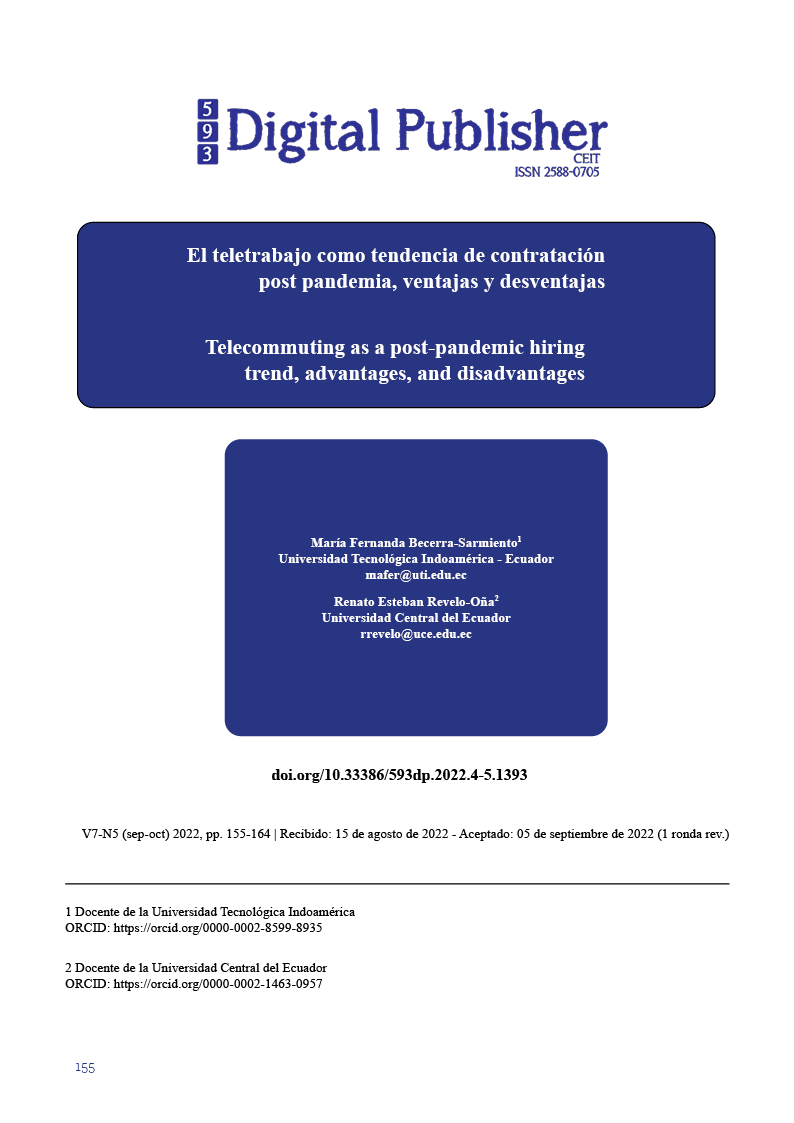Telecommuting as a post-pandemic hiring trend, advantages, and disadvantages
Main Article Content
Abstract
The purpose of this research is to determine if the advantages and disadvantages of telecommuting can influence it to become a hiring trend. The research was inductive to contrast teleworking and the face-to-face modality. A survey was applied to 88 public and private companies and NGOs in the four regions of Ecuador. Women outnumber men in telecommuting; however, men would like telecommuting more than women. Service and commercial companies applied telework to more than 50% of their employees. The advantages and disadvantages of telecommuting are the same worldwide. Nonetheless, in Latin America, there are no clear regulations or policies for teleworking, which generates disadvantages. In public companies, people with small children, disabilities, or remote jobs are candidates to be telecommuters. Telecommuting is the new hiring trend of the 21st century that provides savings and effectiveness, but to be successful, it must be accepted or requested by the employee and not imposed by the company.
Downloads
Article Details

This work is licensed under a Creative Commons Attribution-NonCommercial-ShareAlike 4.0 International License.
1. Derechos de autor
Las obras que se publican en 593 Digital Publisher CEIT están sujetas a los siguientes términos:
1.1. 593 Digital Publisher CEIT, conserva los derechos patrimoniales (copyright) de las obras publicadas, favorece y permite la reutilización de las mismas bajo la licencia Licencia Creative Commons 4.0 de Reconocimiento-NoComercial-CompartirIgual 4.0, por lo cual se pueden copiar, usar, difundir, transmitir y exponer públicamente, siempre que:
1.1.a. Se cite la autoría y fuente original de su publicación (revista, editorial, URL).
1.1.b. No se usen para fines comerciales u onerosos.
1.1.c. Se mencione la existencia y especificaciones de esta licencia de uso.
References
Benavides, F. & Silva, M., 2022. Datos y evidencias del teletrabajo, antes y durante la pandemia por COVID-19. Archivos de prevención de riesgos laborales, 25(2).
Benjumea, M., Villa, E. & Valencia, J., 2016. Beneficios e impactos del teletrabajo en el talento humano. Resultados desde una revisión de literatura.. Revista CEA, 2(4), pp. 59-73.
Castellano, M., Caridad, M., Virviescas, J. & Martínez, J., 2017. Telework as a competitive labor strategy in Colombian PYME. Espacios, 38(31), p. 14.
Dávila, R., Agüero, E., Castro, L. & Vargas, A., 2022. Productividad laboral y el teletrabajo en el sector público durante el período de emergencia nacional. Universidad & Sociedad, 14(2), pp. 402-409.
Esquerda, M., 2021. Ventajas, inconvenientes y aspectos éticos del teletrabajo. FMC, 28(4), pp. 207-209.
Filadi, F., DeCastro, R. & Fundao, M., 2020. Ventajas y desventajas del teletrabajo en la administración pública brasileña: análisis de la expe-riencia del SERPRO y la Receita Federal. Cadernos EBAPE.BR, 18(1).
García, M., Silva, C., Salazar, J. & Gavilanez, F., 2021. Modalidad teletrabajo en tiempos de pandemia COVID-19 en Ecuador. Revista de Ciencias Sociales, 27(ESPECIAL 3), pp. 168-180.
Herrera, L., Torres, V. & Montenegro, M., 2021. Teletrabajo y pandemia. Análisis de las condiciones laborales en tiempos de covid-19. Encuentros: revista de Ciencias Humanas, Teoría Social y Pensamiento Crítico, Issue 14, pp. 141-148.
Institución Universitaria Esumer, 2018. El freelance y el teletrabajo: nuevas tendencias en el ámbito laboral. Revista Mercatec, pp. 46-54.
Martínez, R., 2012. Telecommuting as a labor market tendency. Retos, 2(4), pp. 144-155.
Miglioretti, M., Gragnano, A., Margheritti, S. & Picco, E., 2021. Not All Telework is Valuable. Journal of work and organizational Psychology, 37(1), pp. 11-19.
Morales, D. & Pérez, F., 2020. Teletrabajo como estrategia de competitividad y desarrollo para las empresas en el Ecuador. Revista Eruditus, 1(2), pp. 53-70.
Muñoz, A., 2020. El derecho a la desconexión digital en el teletrabajo. Trabajo y derecho: nueva revista de actualidad y relaciones laborales, 12(EXTRA).
Muñoz, F., 2021. The collective rights in teleworking. Trabajo y Derecho, Issue 79.
Ramírez, J. & Perdomo, M., 2019. VENTAJAS Y DESVENTAJAS DE LA IMPLEMENTACIÓN DEL TELETRABAJO, REVISIÓN DE LA LITERATURA.. Revista Competitivad e Innovación, 1(1).
Ramírez, J., Tapia, H. & Vega, C., 2021. Teletrabajo en Sudamérica: Un desafío juridio frente al covid-19. Revista Venezolana de Gerencia, 26(94), pp. 662-677.
Ramos, V., Ramos, C. & Tejera, E., 2020. Teleworking in times of COVID-19. Interamerican Journal of Psychology, 54(3).
Rolón, F. & Sánchez, S., 2018. El teletrabajo ¿una opción laboral acorde con las tendencias y exigencias del mercado o una figura con vacíos legislativos?. Dictamen Libre, Issue 22, pp. 103-122.
Ruiz, L., 2021. The new regulation of teleworking in public administrations: Between urgency and “minimum” flexibility in times of pandemic. Revista General de Derecho Administrativo, Volumen 57.
Sánchez, A., 2021. Effects of home-office on workers' well-being.. Revista de la Asociación Española de Especialistas en Medicina del Trabajo, 30(2), pp. 234-254.
Sanguineti, W., 2020. La noción jurídica de teletrabajo y el teletrabajo realmente existente. Trabajo y Derecho:nueva revista de actualidad y relaciones laborales, Issue 72.
Solís, J., Morocho, Á. & Quevedo, J., 2021. Tendencias del teletrabajo y el impacto en la productividad laboral. Una mirada desde el Covid-19. Gestión, Innovación y Calidad, pp. 307-338.
Tomasina, F. & Pisani, A., 2022. Pros and cons of teleworking in relation to the physical and mental health of the working general population: a narrative exploratory review. Archivos de prevención de riesgos laborales, 25(2).
Torres, P., 2021. Covid-19: Telework in times of pandemic. Historia y Comunicación Social, Volumen 26, pp. 11-18.
Ulate, R., 2020. Teletrabajo y su impacto en la productividad empresarial y la satisfacción laboral de los colaboradores: tendencias recientes.. Revista Tecnología En Marcha, 33(7), pp. 23-31.
Undurraga, R., Simburguer, E. & Mora, C., 2021. Desborde y desazón versus flexibilidad y concentración: Teletrabajo académico y género en tiempos de pandemia.. Polis Santiago, 20(59), pp. 12-38.
UniversidadPeruanadelasAméricas, 2017. Repositorio Institucional. [En línea]
Available at: http://190.119.244.198/handle/upa/156
Velázquez, C. & Vera, M., 2018. Teletrabajo: Una Revisión Teórica sobre sus Ventajas y Desventajas. Revista Investigatio, Issue 10, pp. 41-53.



